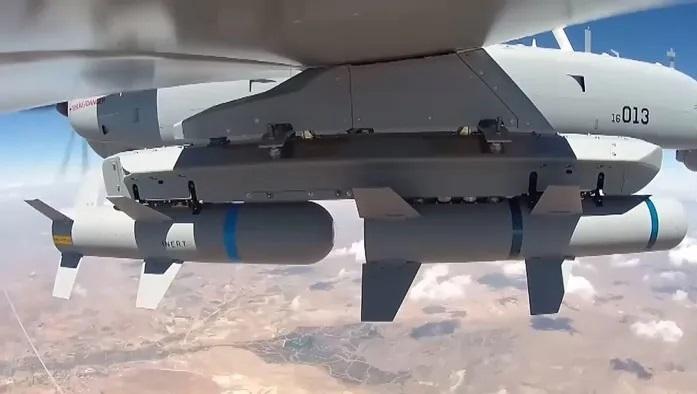Turkish TAI Aksungur unmanned combat aerial vehicle (UCAV) fired Roketsan MAM-L guided bomb against a seaborne target during Exercise Blue Homeland-2022 ( Mavi Vatan-2022 ). MAM-L lightweight guided bomb has been developed for unmanned aerial vehicles, light attack aircraft, and air-to-ground missions. MAM-L offers high strike precision and efficiency with alternative warheads against fixed and mobile targets. MAM (Mini Ak?ll? Mühimmat, meaning Smart Micro Munition) is a family of laser-guided and/or GPS/INS-guided bombs produced by Turkish defense industry manufacturer Roketsan.

The TAI Aksungur (Turkish for gyrfalcon) is an unmanned aerial vehicle (UAV) built by Turkish Aerospace Industries (TAI) for the Turkish Armed Forces. Using existing technology from the TAI Anka series of drones, it is the manufacturer’s largest drone with payload capacity for mission-specific equipment. It is intended to be used for long-term surveillance, signals intelligence, maritime patrol missions, or as an unmanned combat aerial vehicle. TAI planned to integrate weapon packages and put the Aksungur into production in early 2020. The first unit was delivered to the Turkish Naval Forces on 20 October 2021.

The aircraft is 12 m (39 ft) long and 3 m (9.8 ft) high when resting on its landing gear. The high-mounted wings have a slight dihedral angle and a wingspan of 24 m (79 ft). The wings end with small winglets. The centralized fuselage is under the wings and houses avionics, camera, and sensors systems, with a chin-mounted camera blister. Fuel is stored in the fuselage and wings. A turbocharged engine is mounted under each wing, with the engine nacelles each extending back into a tail boom. These tail booms terminate in vertical stabilizers, with a horizontal tailplane joining them. The tricycle landing gear retracts into the engine nacelles and the nose of the aircraft while in flight.

The Aksungur to cruise at a maximum speed of 180 km/h (110 mph) and carry a maximum payload of 750 kg (1,650 lb) to an altitude of 25,000 ft (7,600 m), or ascend to 35,000 ft (11,000 m) with a 150 kg (330 lb) payload. Three hardpoints are situated under each wing for attaching external payloads, such as munitions or sonar buoys. These hardpoints are rated for loads of 150, 300, and 500 kg (330, 660, and 1,100 lb). Proposed armaments include TEBER-81 (laser-guided bomb Mk-81), TEBER-82 (laser-guided bomb Mk-82), LUMTAS, MAM-L, Roketsan Cirit, MAM-C, HGK-3 (precision-guided munition), KGK (82) (winged guided kit), and miniature bomb.












